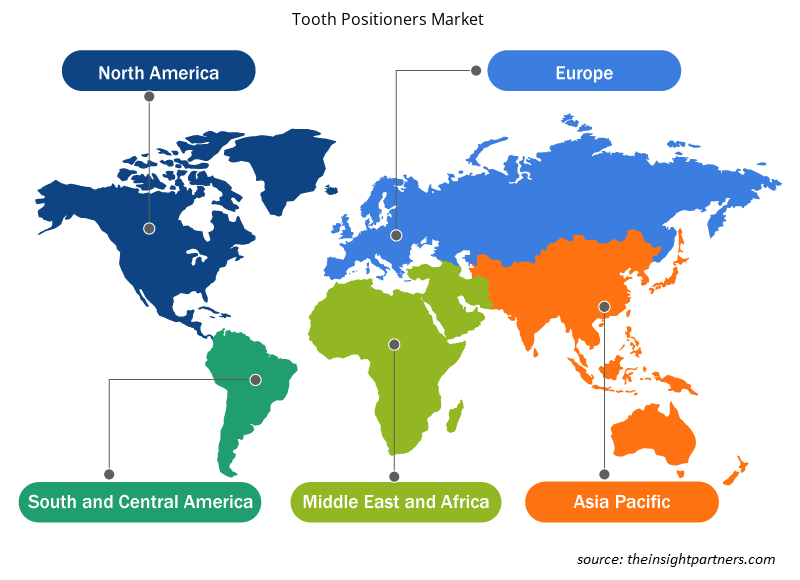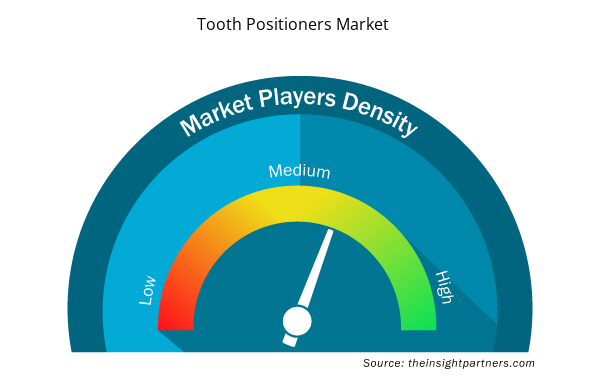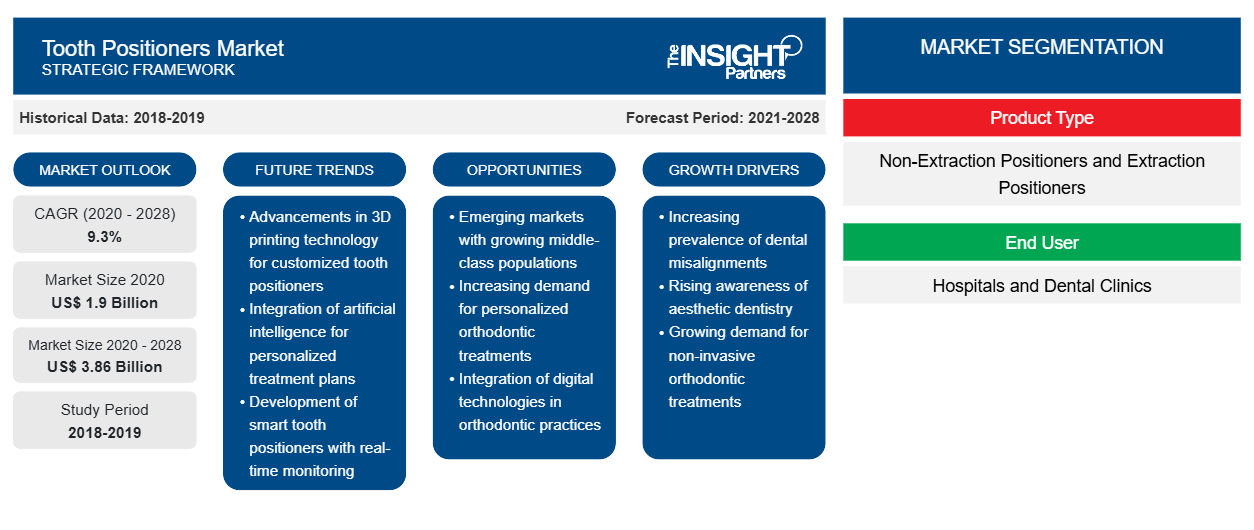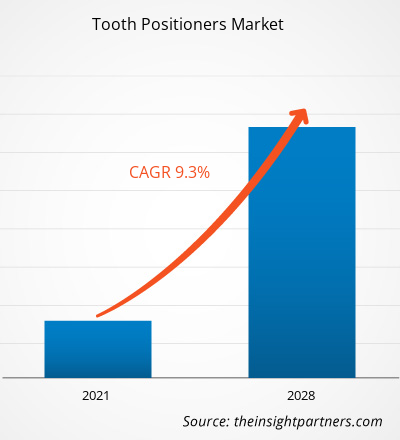Der Markt für Zahnpositionierer wurde im Jahr 2020 auf 1.901,91 Millionen US-Dollar geschätzt und soll bis 2028 3.855,65 Millionen US-Dollar erreichen; für den Zeitraum 2021–2028 wird ein durchschnittliches jährliches Wachstum von 9,3 % erwartet.
Zahnpositionierer sind bekannte kieferorthopädische Geräte, die als bogenförmiger Körper aus einem (silastic) elastischen Material hergestellt werden; sie passen genau in den Mund eines Patienten zwischen den oberen und unteren Zahnbögen. Sie werden verwendet, um Zahnsetzungen zu kontrollieren und einen Rückfall der Zähne nach einer kieferorthopädischen Behandlung zu minimieren oder zu vermeiden.
Die zunehmende Verbreitung von Zahnproblemen führt zur Einführung von Zahnpositionierungssystemen. Zahn- und Mundgesundheitserkrankungen betreffen Menschen mindestens einmal in ihrem Leben. Einfache Zahnschmerzen können unerträgliche Schmerzen, Beschwerden und Entstellungen verursachen. Laut dem 2019 veröffentlichten Bericht der American Dental Association waren 2016 50,4 % der Kinder mit Medicaid oder CHIP und 67,1 % der Kinder mit privater Krankenversicherung beim Zahnarzt. Parodontitis, die zu Zahnverlust führt, steht weltweit an 11. Stelle der am weitesten verbreiteten Zahnerkrankungen. Die Prävalenz von Zahn- und Munderkrankungen wie Überbiss, schiefen Zähnen, Unterbiss, Kreuzbiss, Zahnlücken, Zahnengstand und Kiefergelenkserkrankungen (TMD) nimmt weltweit zu. Die Hauptfaktoren, die zu Zahnproblemen führen, sind Verletzungen, Parodontitis, Unfälle und andere. Laut den Daten der Canadian Association of Orthodontists werden in Kanada und den USA etwa 4 Millionen Menschen von einem Kieferorthopäden behandelt. Laut Angaben der Centers for Disease Control and Prevention (CDC) litten zwischen 2013 und 2016 etwa 31,6 % der US-Bevölkerung an unbehandelter Karies. Darüber hinaus besuchten laut einem 2018 veröffentlichten Umfragebericht 62 % der Befragten 2016 mindestens einmal ihren Zahnarzt, und während 62 % von ihnen 2017 mindestens einmal zum Zahnarzt gingen, vereinbarten 52 % ihren letzten Termin für eine regelmäßige Kontrolluntersuchung. Daher treibt die zunehmende Verbreitung von Zahnproblemen das Wachstum des Marktes für Zahnpositionierer an.
Passen Sie diesen Bericht Ihren Anforderungen an
Sie erhalten kostenlos individuelle Anpassungen an jedem Bericht, einschließlich Teilen dieses Berichts oder einer Analyse auf Länderebene, eines Excel-Datenpakets sowie tolle Angebote und Rabatte für Start-ups und Universitäten.
- Holen Sie sich die wichtigsten Markttrends aus diesem Bericht.Dieses KOSTENLOSE Beispiel umfasst eine Datenanalyse von Markttrends bis hin zu Schätzungen und Prognosen.
Markteinblicke
Kosmetische Zahnmedizin ist eine der häufigsten kosmetischen Behandlungen der Welt. Die American Academy of Dentistry (AACD) ist die wichtigste Ressource für Patienten, wenn es um die Erhaltung ihres Wohlbefindens, ihrer Arbeitsleistung und ihres Aussehens geht. Laut der American Society for Cosmetic Surgery (ASPS) erlebte die Zahnmedizin in letzter Zeit einen Boom, wobei die Zahl der Behandlungen, die von Menschen im Alter von 51, 51–64 bis 64 Jahren nachgefragt wurden, um 47 % zunahm. Die Kosten für Zahnkosmetik sind in nordamerikanischen Ländern geringer. Typische kosmetische Zahnbehandlungen und erstklassige kosmetische Zahnbehandlungen in nordamerikanischen Ländern haben einen Kostenunterschied von ca. 50–150 US-Dollar pro Krone oder Veneer. Zahnärzte in Mexiko verfügen über hochwertige Labore und bieten günstige Kronen an.AACD) is the primary resource for patients as they to maintain their welfare, work performance, and appearance. in step with the American Society for cosmetic surgery (ASPS), dentistry old a recent boom with a 47% increase in procedures demanded by people age fifty one 51–64 to sixty-four years. The costs of dental cosmetics are less in North American countries. Typical cosmetic tooth doctor procedures and prime cosmetic tooth doctor procedures in North American countries have a cost difference of ~US$ 50–150 per crown or veneer. Dentists in Mexico have high-quality labs and provide cheap crowns.
Produkte: Technologieeinblicke
Der globale Markt für Zahnpositionierer ist je nach Produkttyp in Nichtextraktionspositionierer und Extraktionspositionierer unterteilt. Das Segment der Nichtextraktionspositionierer hatte im Jahr 2020 einen größeren Marktanteil. Es wird jedoch erwartet, dass dasselbe Segment im Prognosezeitraum eine höhere durchschnittliche jährliche Wachstumsrate (CAGR) auf dem Markt verzeichnet.
Endbenutzer:
Basierend auf dem Endverbraucher ist der globale Markt für Zahnpositionierer in Krankenhäuser und Zahnkliniken unterteilt. Das Krankenhaussegment hatte 2020 den größten Marktanteil, und das Segment Zahnkliniken dürfte zwischen 2021 und 2028 die höchste durchschnittliche jährliche Wachstumsrate verzeichnen.
Auf dem Markt für Zahnpositionierer tätige Akteure verfolgen Kooperations- und Partnerschaftsstrategien, um die Anforderungen der Endbenutzer durch die Einführung technologisch fortschrittlicher Angebote zu erfüllen, und diese Strategien unterstützen das Wachstum des Marktes erheblich.
Regionale Einblicke in den Markt für Zahnpositionierer
Die regionalen Trends und Faktoren, die den Markt für Zahnpositionierer im gesamten Prognosezeitraum beeinflussen, wurden von den Analysten von Insight Partners ausführlich erläutert. In diesem Abschnitt werden auch die Marktsegmente und die Geografie von Zahnpositionierern in Nordamerika, Europa, im asiatisch-pazifischen Raum, im Nahen Osten und Afrika sowie in Süd- und Mittelamerika erörtert.

- Erhalten Sie regionale Daten zum Markt für Zahnpositionierer
Umfang des Marktberichts zu Zahnpositionierern
| Berichtsattribut | Details |
|---|---|
| Marktgröße im Jahr 2020 | 1,9 Milliarden US-Dollar |
| Marktgröße bis 2028 | 3,86 Milliarden US-Dollar |
| Globale CAGR (2020 - 2028) | 9,3 % |
| Historische Daten | 2018-2019 |
| Prognosezeitraum | 2021-2028 |
| Abgedeckte Segmente | Nach Produkttyp
|
| Abgedeckte Regionen und Länder | Nordamerika
|
| Marktführer und wichtige Unternehmensprofile |
|
Dichte der Marktteilnehmer für Zahnpositionierer: Die Auswirkungen auf die Geschäftsdynamik verstehen
Der Markt für Zahnpositionierer wächst rasant, angetrieben durch die steigende Nachfrage der Endnutzer aufgrund von Faktoren wie sich entwickelnden Verbraucherpräferenzen, technologischen Fortschritten und einem größeren Bewusstsein für die Vorteile des Produkts. Mit steigender Nachfrage erweitern Unternehmen ihr Angebot, entwickeln Innovationen, um die Bedürfnisse der Verbraucher zu erfüllen, und nutzen neue Trends, was das Marktwachstum weiter ankurbelt.
Die Marktteilnehmerdichte bezieht sich auf die Verteilung der Firmen oder Unternehmen, die in einem bestimmten Markt oder einer bestimmten Branche tätig sind. Sie gibt an, wie viele Wettbewerber (Marktteilnehmer) in einem bestimmten Marktraum im Verhältnis zu seiner Größe oder seinem gesamten Marktwert präsent sind.
Die wichtigsten auf dem Markt für Zahnpositionierer tätigen Unternehmen sind:
- TP Orthodontics, Inc.
- Align Kieferorthopädie
- Dockstader Orthodontic Lab, Inc.
- DENTAURUM GmbH & Co. KG
- 3M
Haftungsausschluss : Die oben aufgeführten Unternehmen sind nicht in einer bestimmten Reihenfolge aufgeführt.

- Überblick über die wichtigsten Akteure auf dem Markt für Zahnpositionierer
Nach Produkttyp
- Positionierer ohne Extraktion
- Extraktionspositionierer
Nach Endbenutzer
- Krankenhäuser
- Zahnkliniken
Nach Geografie
Nordamerika
- UNS
- Kanada
- Mexiko
Europa
- Frankreich
- Deutschland
- Italien
- Vereinigtes Königreich
- Spanien
Asien-Pazifik
- China
- Indien
- Südkorea
- Japan
- Australien
Naher Osten und Afrika
- Südafrika
- Saudi-Arabien
- Vereinigte Arabische Emirate
Süd- und Mittelamerika
- Brasilien
- Argentinien
Firmenprofile
- TP Orthodontics, Inc.
- Align Kieferorthopädie
- Dockstader Orthodontic Lab, Inc.
- DENTAURUM GmbH & Co. KG
- 3M
- DENTSPLY Sirona
- G&H Kieferorthopädie
- DynaFlex
- Protec Dentallabore
- Johns Dentallabor
- Historische Analyse (2 Jahre), Basisjahr, Prognose (7 Jahre) mit CAGR
- PEST- und SWOT-Analyse
- Marktgröße Wert/Volumen – Global, Regional, Land
- Branche und Wettbewerbsumfeld
- Excel-Datensatz



Report Coverage
Revenue forecast, Company Analysis, Industry landscape, Growth factors, and Trends

Segment Covered
This text is related
to segments covered.

Regional Scope
North America, Europe, Asia Pacific, Middle East & Africa, South & Central America

Country Scope
This text is related
to country scope.
Häufig gestellte Fragen
The uneasiness and inconvenience caused by tooth positioners is the significant factor that will hinder the tooth positioners market growth.
The global tooth positioners market is being driven by factors such as rising prevalence of dental problems and increase in demand for dental cosmetic procedures are likely to offer significant opportunities for the growth of the global tooth positioners market.
TP Orthodontics, Inc., Align Orthodontics, Dockstader Orthodontic Lab, Inc., DENTAURUM GmbH & Co. KG, 3M, DENTSPLY GAC International, G&H Orthodontics, DynaFlex, LM-Instruments Oy., Johns Dental Laboratories and among others are major companies operating in this market.
Trends and growth analysis reports related to Life Sciences : READ MORE..
The List of Companies - Tooth Positioners Market
- TP Orthodontics, Inc.
- Align Orthodontics
- Dockstader Orthodontic Lab, Inc.
- DENTAURUM GmbH & Co. KG
- 3M
- DENTSPLY Sirona
- G&H Orthodontics
- DynaFlex
- Protec Dental laboratories
- Johns Dental Laboratories
The Insight Partners performs research in 4 major stages: Data Collection & Secondary Research, Primary Research, Data Analysis and Data Triangulation & Final Review.
- Data Collection and Secondary Research:
As a market research and consulting firm operating from a decade, we have published and advised several client across the globe. First step for any study will start with an assessment of currently available data and insights from existing reports. Further, historical and current market information is collected from Investor Presentations, Annual Reports, SEC Filings, etc., and other information related to company’s performance and market positioning are gathered from Paid Databases (Factiva, Hoovers, and Reuters) and various other publications available in public domain.
Several associations trade associates, technical forums, institutes, societies and organization are accessed to gain technical as well as market related insights through their publications such as research papers, blogs and press releases related to the studies are referred to get cues about the market. Further, white papers, journals, magazines, and other news articles published in last 3 years are scrutinized and analyzed to understand the current market trends.
- Primary Research:
The primarily interview analysis comprise of data obtained from industry participants interview and answers to survey questions gathered by in-house primary team.
For primary research, interviews are conducted with industry experts/CEOs/Marketing Managers/VPs/Subject Matter Experts from both demand and supply side to get a 360-degree view of the market. The primary team conducts several interviews based on the complexity of the markets to understand the various market trends and dynamics which makes research more credible and precise.
A typical research interview fulfils the following functions:
- Provides first-hand information on the market size, market trends, growth trends, competitive landscape, and outlook
- Validates and strengthens in-house secondary research findings
- Develops the analysis team’s expertise and market understanding
Primary research involves email interactions and telephone interviews for each market, category, segment, and sub-segment across geographies. The participants who typically take part in such a process include, but are not limited to:
- Industry participants: VPs, business development managers, market intelligence managers and national sales managers
- Outside experts: Valuation experts, research analysts and key opinion leaders specializing in the electronics and semiconductor industry.
Below is the breakup of our primary respondents by company, designation, and region:

Once we receive the confirmation from primary research sources or primary respondents, we finalize the base year market estimation and forecast the data as per the macroeconomic and microeconomic factors assessed during data collection.
- Data Analysis:
Once data is validated through both secondary as well as primary respondents, we finalize the market estimations by hypothesis formulation and factor analysis at regional and country level.
- Macro-Economic Factor Analysis:
We analyse macroeconomic indicators such the gross domestic product (GDP), increase in the demand for goods and services across industries, technological advancement, regional economic growth, governmental policies, the influence of COVID-19, PEST analysis, and other aspects. This analysis aids in setting benchmarks for various nations/regions and approximating market splits. Additionally, the general trend of the aforementioned components aid in determining the market's development possibilities.
- Country Level Data:
Various factors that are especially aligned to the country are taken into account to determine the market size for a certain area and country, including the presence of vendors, such as headquarters and offices, the country's GDP, demand patterns, and industry growth. To comprehend the market dynamics for the nation, a number of growth variables, inhibitors, application areas, and current market trends are researched. The aforementioned elements aid in determining the country's overall market's growth potential.
- Company Profile:
The “Table of Contents” is formulated by listing and analyzing more than 25 - 30 companies operating in the market ecosystem across geographies. However, we profile only 10 companies as a standard practice in our syndicate reports. These 10 companies comprise leading, emerging, and regional players. Nonetheless, our analysis is not restricted to the 10 listed companies, we also analyze other companies present in the market to develop a holistic view and understand the prevailing trends. The “Company Profiles” section in the report covers key facts, business description, products & services, financial information, SWOT analysis, and key developments. The financial information presented is extracted from the annual reports and official documents of the publicly listed companies. Upon collecting the information for the sections of respective companies, we verify them via various primary sources and then compile the data in respective company profiles. The company level information helps us in deriving the base number as well as in forecasting the market size.
- Developing Base Number:
Aggregation of sales statistics (2020-2022) and macro-economic factor, and other secondary and primary research insights are utilized to arrive at base number and related market shares for 2022. The data gaps are identified in this step and relevant market data is analyzed, collected from paid primary interviews or databases. On finalizing the base year market size, forecasts are developed on the basis of macro-economic, industry and market growth factors and company level analysis.
- Data Triangulation and Final Review:
The market findings and base year market size calculations are validated from supply as well as demand side. Demand side validations are based on macro-economic factor analysis and benchmarks for respective regions and countries. In case of supply side validations, revenues of major companies are estimated (in case not available) based on industry benchmark, approximate number of employees, product portfolio, and primary interviews revenues are gathered. Further revenue from target product/service segment is assessed to avoid overshooting of market statistics. In case of heavy deviations between supply and demand side values, all thes steps are repeated to achieve synchronization.
We follow an iterative model, wherein we share our research findings with Subject Matter Experts (SME’s) and Key Opinion Leaders (KOLs) until consensus view of the market is not formulated – this model negates any drastic deviation in the opinions of experts. Only validated and universally acceptable research findings are quoted in our reports.
We have important check points that we use to validate our research findings – which we call – data triangulation, where we validate the information, we generate from secondary sources with primary interviews and then we re-validate with our internal data bases and Subject matter experts. This comprehensive model enables us to deliver high quality, reliable data in shortest possible time.


 Holen Sie sich ein kostenloses Muster für diesen Bericht
Holen Sie sich ein kostenloses Muster für diesen Bericht